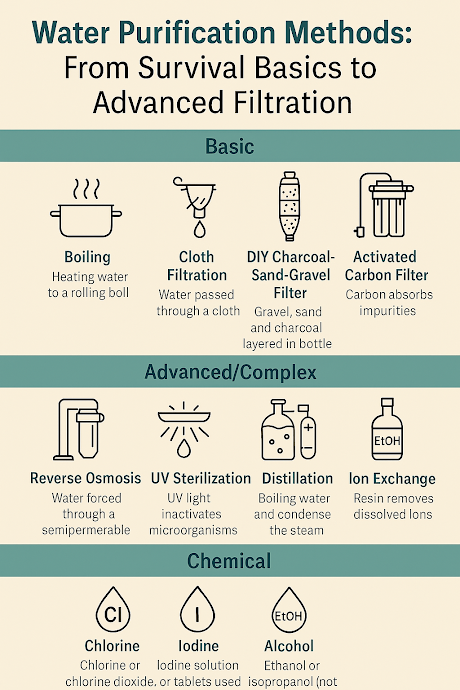Water Purification Methods: From Survival Basics to Advanced Filtration
Clean water is essential for life—not just for humans, but for animals and plants as well. In a world where water sources are increasingly exposed to contaminants, knowing how to purify water sustainably is more important than ever. Whether you're preparing for an off-grid lifestyle, planning a wilderness trek, or simply upgrading your home system, this comprehensive guide covers everything from primitive survival methods to advanced filtration technologies—with vital considerations for human, pet, and plant health.
 |
| Infographic showing water purification methods from basic survival to advanced home filtration, including boiling, filters, UV, chemicals, and health safety tips. |
Basic Water Purification Methods
1. Boiling
Boiling water is the simplest and most effective emergency disinfection method. Bringing water to a rolling boil for 1 to 3 minutes destroys most bacteria, viruses, and parasites. It does not remove chemicals or sediment, making it best used with pre-filtration like cloth or sand.
Health note: Boiled water is safe for humans and pets. However, for sensitive plants, allow boiled water to cool and sit uncovered to release any volatile chlorine.
2. Cloth Filtration
Passing water through a clean cloth, bandana, or coffee filter removes visible debris and larger protozoan cysts. This method is often used before chemical or UV disinfection.
Use tip: Pre-filter murky water to protect more delicate filtration systems and to reduce chemical usage in the next step.
3. DIY Charcoal-Sand-Gravel Filters
Layer gravel, sand, and activated charcoal in a bottle or pipe to create a survival filter. This setup mimics the action of commercial slow sand filters and removes sediment, odors, and some bacteria.
Caution: Always follow with boiling, chemical disinfection, or UV if drinking the water.
Household Water Filtration Systems
4. Activated Carbon Filters
These filters absorb organic chemicals, chlorine, and improve taste and odor. Common brands like Brita and PUR use this method in pitcher and faucet-mount systems.
Health concern: These filters do not remove pathogens. Never rely solely on carbon filters for untreated water sources.
5. Ceramic Filters
Found in systems like Berkey, ceramic filters block bacteria and protozoa. When paired with carbon cores or fluoride-reducing filters, they provide robust filtration for home use.
Safe for pets and plants when used with clean water sources.
6. Reverse Osmosis (RO) Systems
RO forces water through a semi-permeable membrane to remove salts, heavy metals, pathogens, and most dissolved solids. Many systems combine RO with sediment and carbon stages.
Note: RO also removes beneficial minerals. For plants, this water may be too “clean”—remineralization is often necessary.
7. UV Sterilization
UV light neutralizes bacteria, viruses, and protozoa without chemicals. UV pens like SteriPEN or inline home UV units are excellent add-ons to filtered systems.
Caution: Water must be clear; cloudy water blocks UV rays and makes treatment ineffective.
8. Distillation
Boiling and condensing water leaves behind contaminants, including heavy metals and microbes. Distillation is slow but thorough, ideal for emergency preparedness.
Safe for all uses, though distilled water lacks minerals—supplement for plant watering.
9. Ion Exchange (Water Softeners)
These systems remove calcium and magnesium, reducing scale and “hardness.” Though not purification systems per se, they improve appliance efficiency and soap performance.
Not for drinking without additional filtration—elevated sodium levels may harm pets and sensitive plants.
Wilderness and Emergency Purification
10. Portable Filters
Backpackers rely on LifeStraw, Sawyer Mini, and Katadyn filters using hollow fiber or ceramic membranes. These remove bacteria and protozoa, but not viruses or chemicals unless explicitly stated.
11. Chemical Disinfection
Chlorine and Chlorine Dioxide
-
Liquid bleach (4–6%): 2–4 drops per liter, wait 30 min.
-
Chlorine dioxide tablets: Kills viruses and protozoa, wait 30–60 min.
Safe for emergency drinking water, but may be harsh on pet digestion or plant roots. Use sparingly or flush containers afterward.
Iodine
-
5–10 drops or 1 tablet per liter, 30–60 minutes wait.
-
Not recommended for long-term use, pregnant women, or people with thyroid issues.
Warning: Not ideal for watering plants or animals due to toxicity concerns.
12. Chemical Myths: Alcohol and Hydrogen Peroxide
While common in first aid, alcohol is not a reliable water disinfectant. Likewise, hydrogen peroxide lacks sufficient power to purify water on its own. These are best left to surface sanitation.
Plant & Animal Health Considerations
-
Pets: Can tolerate most human-safe purified water, but sensitive species (like fish or reptiles) require dechlorinated and mineral-balanced water.
-
Plants: Most prefer filtered or dechlorinated water. RO and distilled water can strip soil nutrients without mineral supplements.
-
Chlorine-sensitive crops (like lettuce, spinach, and orchids) may exhibit stunted growth or leaf burn from chemically treated water.
Conclusion: Choosing a Water Purification Method
Each method has its strengths, depending on the scenario:
| Situation | Recommended Method(s) |
|---|---|
| Home filtration | RO + Carbon, Berkey, UV, or Whole-House Filters |
| Wilderness survival | Ceramic or hollow fiber filter + chlorine dioxide |
| Emergency prep | Boiling + chlorine tablets + DIY charcoal filter |
| Safe water for plants | Carbon-filtered or dechlorinated tap water |









Comments
Post a Comment